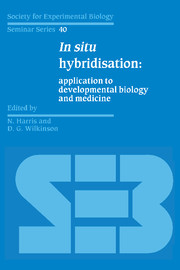Book contents
- Frontmatter
- Contents
- List of contributors
- Preface
- Non-radioisotopic labels for in situ hybridisation histochemistry: a histochemist's view.
- Use of haptenised nucleic acid probes in fluorescent in situ hybridisation
- The use of complementary RNA probes for the identification and localisation of peptide messenger RNA in the diffuse neuroendocrine system
- Contributions of the spatial analysis of gene expression to the study of sea urchin development
- Advantages and limitations of in situ hybridisation as exemplified by the molecular genetic analysis of Drosophila development
- The use of in situ hybridisation to study the localisation of maternal mRNAs during Xenopus oogenesis
- In situ hybridisation in the analysis of genes with potential roles in mouse embryogenesis
- Evolution of algal plastids from eukaryotic endosymbionts
- Localisation of expression of male flower-specific genes from maize by in situ hybridisation
- Tissue preparation techniques for in situ hybridisation studies of storage-protein gene expression during pea seed development
- Investigation of gene expression during plant gametogenesis by in situ hybridisation
- Sexing the human conceptus by in situ hybridisation
- Non-isotopic in situ hybridisation in human pathology
- The demonstration of viral DNA in human tissues by in situ DNA hybridisation
- Index
Non-isotopic in situ hybridisation in human pathology
Published online by Cambridge University Press: 04 August 2010
- Frontmatter
- Contents
- List of contributors
- Preface
- Non-radioisotopic labels for in situ hybridisation histochemistry: a histochemist's view.
- Use of haptenised nucleic acid probes in fluorescent in situ hybridisation
- The use of complementary RNA probes for the identification and localisation of peptide messenger RNA in the diffuse neuroendocrine system
- Contributions of the spatial analysis of gene expression to the study of sea urchin development
- Advantages and limitations of in situ hybridisation as exemplified by the molecular genetic analysis of Drosophila development
- The use of in situ hybridisation to study the localisation of maternal mRNAs during Xenopus oogenesis
- In situ hybridisation in the analysis of genes with potential roles in mouse embryogenesis
- Evolution of algal plastids from eukaryotic endosymbionts
- Localisation of expression of male flower-specific genes from maize by in situ hybridisation
- Tissue preparation techniques for in situ hybridisation studies of storage-protein gene expression during pea seed development
- Investigation of gene expression during plant gametogenesis by in situ hybridisation
- Sexing the human conceptus by in situ hybridisation
- Non-isotopic in situ hybridisation in human pathology
- The demonstration of viral DNA in human tissues by in situ DNA hybridisation
- Index
Summary
Introduction
In situ hybridisation (ISH) may be defined as the direct detection of nucleic acid in intact cellular material. Nucleic acids may be exogenous or endogenous, nuclear or cytoplasmic, DNA or RNA. A variety of cell and tissue samples can be studied using ISH, from individual chromosomes in metaphase spreads to archival paraffin embedded biopsy material. Using appropriately labelled probes, the presence or absence of normal and abnormal nucleic acids can not only be detected but can also be correlated with cell and tissue morphology. This provides a wealth of information regarding both the genotype and phenotype of cells within pathological lesions and will, by combination with other techniques such as immunocytochemistry, allow greater understanding of the pathophysiology of abnormal cells and the interactions between them.
The technique of in situ hybridisation was originally described in 1969 for the detection of abundant ribosomal RNA sequences in non-mammalian systems with 32P-labelled probes (Gall & Pardue, 1969; John et al., 1969). By increasing the sensitivity of detection and resolution of the procedure, using isotopes of high specific activity and shorter track length than 32P (e.g. 125I, 35S, 3H), single copy genes were visualised on chromosomes (Gerhard et al., 1981). In the 1980s, non-isotopic in situ hybridisation (NISH) has been developed for gene localisation which is as sensitive as radioisotopic techniques. Single copy genes have now been mapped on chromosomes by NISH (Bhatt et al., 1988). In human disease, ISH can be applied to the detection of normal and abnormal nucleic acids. Development of techniques for ISH has been directed, in the context of laboratory medicine, towards procedures which are clinically useful.
- Type
- Chapter
- Information
- In Situ HybridisationApplication to Developmental Biology and Medicine, pp. 241 - 270Publisher: Cambridge University PressPrint publication year: 1990
- 3
- Cited by



